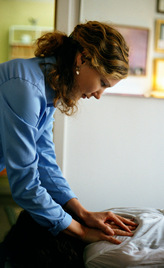| Sylvia Skefich, D.C. |
|
Who does not experience stress on a near daily basis anymore? Even the stress of getting to our appointments on time, to meeting deadlines, to managing the traffic, to paying our bills, and completing all that we have intended to get done can get overwhelming. The body helps us out as best it can. It will adapt quietly in bad postures while we work, it will manage the chemicals of stress and inflammation that we bring upon it, and will spring tight, getting ready for action, even just with mental activity. The body is a great compensator, working silently behind the scenes to support our activities. The last thing the body wants to do is cry out for help. How far would we have come along as a species if the body was always acting out in pain and discomfort, saying “Me! Me! Me!” whenever there was a strain. It is as though our body is a bucket, capable of holding a certain amount of stress before it overflows into pain. The stress-bucket is our buffer zone. Fill it up, and get pain. The body will adapt to a less than optimal situation by compensating. Stress will fill your “stress-bucket,” but so will bodily compensations to the stress. If there is inflammation, then a fibrous build-up will follow to strengthen the area. So for instance, repetitive stress injuries (like from keyboarding or mousing), or a bad posture creating a strain to a region (as in the midscapular region from slumping), creates chronic low grade inflammation. Inflammation is a chemical call for microscopic fibers to come and build up matting throughout the area in order to strengthen it. This strong matting is compensation. The compensation gets added to the stress-bucket, filling it closer to the top. And it doesn’t stop there…. When a matted, fibrotic area (we all have them) is present, then the area no longer moves as it was intended to. This creates other areas to be strained due to a ripple effect of aberrant motion patterns that stem from the original site. Like, if you have your ankle casted (an analogy for a thickened fibrous compensation), then you would walk funny, and then your hip may begin to hurt as it compensates for the ankle. Put the compensating hip in the stress-bucket. In my practice, I’d say 50% of the time, the person experiences the pain at the site of a tight original site. The other 50% of the time, the spot that hurts is simply an area that is compensating for, or counter-balancing an original tight spot. It is a “working” and strained area that is hurting in this case. And so the stress-bucket gets filled with yet more compensation. A good body worker is capable of identifying the compensations from the original sites, is able to normalize the function of both types of problem areas (to the best of your body’s ability to heal) and should be able to offer a decisive plan (including number of visits, exercises, or other therapies if needed) to get you out of pain within a reasonable time. (This is equivalent to getting your stress bucket ladled out a good few scoops.) In my practice, I like to offer a treatment plan #1.) to get out of pain, and #2.) to get into the neutral zone where there is no risk of original stressors or compensations building back up to pain anytime too quickly. It is always up to the client to determine what they wish to achieve. Basically, I believe we can be different, lighter people when our stress-bucket is low.
|
Doctor of Chiropractic, Sylvia Skefich – Santa Cruz, California 831-475-1995 |
